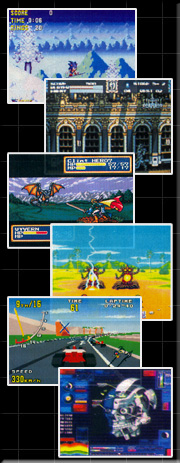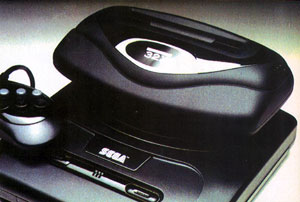

|
X Is Next By Greg Gillis
BY 1994, the 16-bit technology behind the Sega Genesis had begun to show its age. In the wake of increased competition from more powerful game systems like the Atari Jaguar and 3DO, Sega attempted to maintain interest in their console by releasing a series of hardware upgrades and innovations throughout the year. The first of these was the SVP chip, a DSP which provided a dramatic boost to the basic Genesis system's processing power, allowing it to display impressive polygonal graphics smoothly and easily. Although the chip was put to good use in Sega's Genesis conversion of their arcade hit Virtua Racing, the added cost of the technology (with Virtua Racing selling for upwards of $100 upon release) made it somewhat unpalatable for consumers. Sega briefly toyed with the idea of releasing a standalone SVP module along with less expensive compatible games like Virtua Fighter, but this idea was eventually abandoned in favour of an even more ambitious device... The concept of a modular cartridge was never completely dropped, however, as in the Fall of 1994 Sega released their first (and only) Genesis cartridge to feature "lock-on technology" - Sonic & Knuckles. The game was unique in that players could insert older Sonic games into Sonic & Knuckles' own secondary cartridge slot, with added features breathing new life into games that had already been out for years. Sonic & Knuckles also contained a new game in its own right, of course, but it was the game's unique modularity that drew the lions share of media attention upon its release. Towards the end of 1994, everyone knew that Sega intended to release their 32-bit Saturn game system in Japan, but it was unclear when or if the device would be released in North America. Confusing the issue still further was the Fall launch of the 32X - a 32-bit add-on for the Genesis system. Featuring two 32-bit Hitachi SH-2 chips (much like its progenitor the Saturn, although clocked somewhat slower and lacking the Saturn's array of powerful Video Display Processors), the 32X allowed the Genesis system to display texture-mapped polygons with up to 32 768 colours on screen simultaneously. The device also added two PCM sound channels to the basic Genesis audio output, allowing for much improved use of sampled sound as heard on the SNES and Sega CD. Although the initial reaction to the first batch of 32X games was largely positive (with the 32X versions of Virtua Racing Deluxe and Star Wars Arcade in particular receiving favourable reviews), many questioned the long term viability of the device itself. Sega claimed that they intended to support the 32X for years to come as a sort of mid-range product, with the Saturn launching some time in 1995 at a price point that would not make it a "mass market item". To further demonstrate their support, Sega unveiled a prototype Genesis/32X hybrid system called Neptune, which was tentatively scheduled for release in 1995. Whether one considers the 32X to have been a brilliant way to extend the life of the Genesis system or a potentially disastrous distraction from the impending launch of the Saturn, it nevertheless provided a spectacular finish to one of the most interesting years of the 16-bit generation. It would also mark the end of Sega's developmental focus on the base Genesis system as their primary console, and the beginning of the end (perhaps too soon) of the Genesis system itself. "32X takes Genesis one step forward ... But does Sega take two steps back? 32X may make a fast buck in late '94, but it could cost Sega dearly in 1995." |
